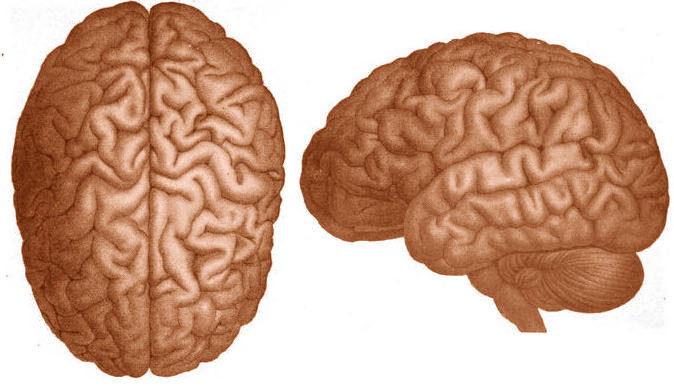What seemed like harmless fun riding ATVs with friends took a turn for the worse when Daniel Stunkard was thrown from the vehicle and hit the road.
Stunkard wasn’t wearing a helmet at time, and ended up in a coma for three and a half weeks. When he woke up, he was partially paralyzed.
“The [nerve] fibers that controlled my arm were 67 percent missing and the fibers that controlled my hand were 97 percent missing,” Stunkard said.
Stunkard, who was treated at UPMC, suffered from Traumatic Brain Injury. For more than 90 percent of TBI cases, no existing method can detect the exact areas of the brain that are damaged. But Walter Schneider — a psychology professor at Pitt and neurosurgery professor at UPMC — developed a method to combat this problem.
The brain is made up of a system of axons through which brain cells communicate. These axons link together to form cable-like structures, called tracts, which are composed of nerve fibers. Schneider developed high-definition fiber tracking, a method which processes a brain scan through computer algorithms to reveal the detailed wiring of the brain down to the axon level and identify injured areas.
“Think of the cables in your brain as the cables in your car,” Schneider said. “If you have a car crash maybe you lose your lights, or the radio — something is broken in the circuit diagram. If one suffers TBI, there’s now the ability to map the brain cables to identify what was broken, similar to how you can in a car accident.”
Schneider first began developing the technology for HDFT in 2008. Techniques for brain imaging at the time — such as magnetic resonance imaging, otherwise known as MRI — could only detect a small percentage of the damage caused by TBI because the imaging was not as detailed. Schneider wanted to develop a method for acquiring more comprehensive images.
His recent work has focused on quantifying the extent of damage to the brain and can be applied in planning for neurosurgery — the technology can identify tracts that need to be avoided during surgery and can identify tracts that have already been damaged. By identifying damaged tracts, clinicians can determine the proper intervention, such as physical therapy.
In order to complete the task of targeting damaged tracts and preserving functional ones, clinical application is needed in addition to research. Dr. David Okonkwo, professor and executive vice chair of neurological surgery at Pitt, has played a large role in the HDFT project.
Okonkwo met Schneider seven years ago when he saw Schneider give a lecture on his early TBI technology. Okonkwo recognized instantly it could be of benefit to the field of TBI.
“Following the lecture, he and I met and talked about the challenges with diagnoses in TBI,” Okonkwo said. “We then crafted the first set of studies that would help uncloak whether HDFT could contribute to our understanding of TBI and its consequences.”
HDFT is only available in research settings at present, according to Okonkwo. Schneider and his lab are working with companies that make MRI machines to move HDFT into a clinical space where it can be available to physicians and patients within the next couple of years.
Okonkwo also helped with Stunkard’s TBI case, using HDFT to assess the areas of Stunkard’s brain that had sustained injury. The team decided to first bring Stunkard’s leg sensations back, because with HDFT they could see his legs suffered least from the injury.
“If we had started on his hand, we would’ve gotten frustrated with the physical therapy since most of his function was missing,” Schneider said. “Because we started with his legs, we maximized benefit for this individual.”
Stunkard said the scan gave him hope and a direction for the future.
“Instead of being hopeless, I realized I could get function back,” Stunkard said. “I couldn’t walk, talk, eat or do anything and this got me to where I’m at now.”
Stunkard has progressed to the point that he can now walk, but he hasn’t recovered completely — his hands still begin to feel numb from small movements with his fingers such as texting. And because the part of his brain that controls the left side of the body suffered more severe injuries, Stunkard — who was previously left-handed — now has to train himself to be right-hand dominant.
In addition to dealing with TBI cases, Schneider has also started working on diagnosing Chronic Traumatic Encephalopathy — a degenerative brain disease found in athletes, military veterans and others with a history of repetitive brain trauma. CTE can only be diagnosed after death through brain tissue analysis with current technology.
Schneider said his team has an ongoing project using positron emission tomography markers — which are used to observe metabolic processes in the body — to look at the markers’ buildup. Schneider said buildup of these markers is a “classic sign of CTE.”
“Looking at HDFT measures we can predict if we do or do not have the buildup. We have some initial results that are suggestive it can be possible,” Schneider said.
Despite these research milestones, Okonkwo and Schneider’s work is not done. Okonkwo said over the last couple years, HDFT technology has improved with higher resolution imaging, and Okonkwo and Schneider hope to continue to improve it.
“Our goal is to perfect the HDFT imaging such that it becomes a valuable tool for clinicians who are trying to understand the reason for changes in performance with patients with neurological disorders,” Okonkwo said.
Schneider also has high hopes for proper clinical assessment — being able to identify the exact tracts of the brain where the damage is.
“The goal is when someone comes in with TBI, to fix the things they cannot do that they used to be able to,” Schneider said.


